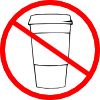
One of the most exciting design challenges is for the cup itself. What will it look like, what material will it be made of, how will a lid work, etc. Here are some things I think are important.
Cheap: cups must be inexpensive to produce/replace and not something of high value that people will steal/horde
Durable: cups must stand up to 1000's of use, wash cycles
Food safe: this would seem to go without saying, but the endocrine disruptor BPA kept popping up in the last few years in our favorite water bottles. See BPA aside below.
Lid-able: need to be able to put a lid on it. possibly both sipper lid and hole-free lid.
Use-safe: the cups should be thick-walled enough or otherwise designed so you don't burn yourself holding it, you should be able to set it down without it tipping over, you should be able to put it in a cup holder in a car. These relate to two items above.
Right-sized: cups that are too small or too big won't be embraced by businesses or customers.
Stackable: after sanitizing, cups must be drip dried (not wiped) per sanitation code. Racks and racks of cups drying and taking up racks and space would be a pain for either a business washing cups or the central wash. Businesses need to wash cups and immediately put them out for use. Cups (esp. plastic) that fit TOO closely when stacked don't dry and get stinky. Cups should have ribs or other design to maintain a slight gap for drying when stacked. And Portland Cups have got to stack to replace the very stackable and space efficient paper cup. To go on a little tangent, I think that that big stack of paper cups which is so emblematic of a coffee shop, has rooted itself in our minds so that when we think coffee shop, we think of that mountain of former forest. We are comforted by the knowledge that even if we forget our travel mug, the cups will be their waiting for us. I wonder if instead there was a mighty stack of Portland Cups in most every coffee house. Think of the mental map now. Coffee shop -> stacks of durable cups -> I really like my own durable mug, so I think I'll bring it with me today. I predict personal mug use will actually rise with the intro of the Portland Cup simply due to this kind of subtle reminder.
What do I think the above adds up to? Something like this basic plastic tumbler: http://www.arrowplastic.com/store/catalog.asp?item=65
I happen to have several of these at home. I looked at the bottom of the cup and found the manufacturers website. I like the polypropylene (#5 PP) material as it's considered highly food safe, it has a temperature range of something like 0 deg C to 135 deg C (275 deg F). With plastic we could add ribs or something to make stacked drying possible. They would be cheap and yet durable. If made a little thicker than usual, would be extra durable and probably easy on the hands when full of hot stuff (I've tested mine with hot water/coffee and it behaves like a thick paper cup). I would of course add, besides the drying details, screw threads ala mason jar for a screw-on lid. I would in fact use the exact threads that a canning jar uses so that folks that want to can use a solid lid to carry cup by bike etc spill free. Could produce a cheap PP screw on sipper lid. I would put copy on the cup which reads "The Portland Cup", "Not For Resale, For reUse" (kinda cheesy, I know), "http://portlandonline.com/portlandcup". See mockup sketch.
BPA CURRENTS WITH LEX LEXAN
I was really confused about how all of these rigid, clear, often colorful water bottles could be BPA generators one day and BPA-free the next. Especially after reading the wikipedia entry on Polycarbonate (http://en.wikipedia.org/wiki/Polycarbonate) where we learn that #7 PC is made from Bisphenol A and our old friend from WWI, phosgene. Of course you'd get BPA in your H2O every time you used NaOCl (bleach), the bottle is MADE FROM IT. How then could this doomed beverage container material be rendered "BPA-free"? Because it ain't PC anymore, it's TRITAN (http://www.eastman.com/Brands/eastman_tritan/Pages/Overview.aspx). It still may say #7 on the bottle, cuz #7 just means "some plastic other than #1 through #6", but even though this tough, clear material walks like polycarbonate and quacks like polycarbonate, uh...I got nothing, but you get the point.

No comments:
Post a Comment